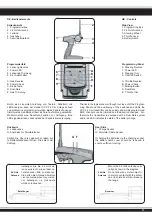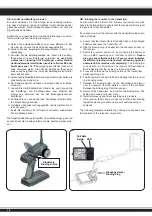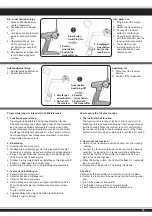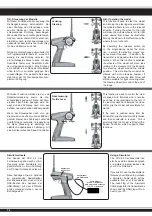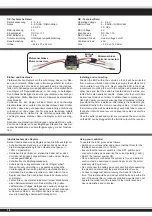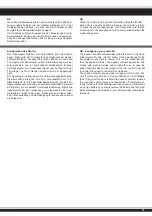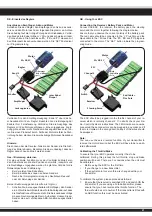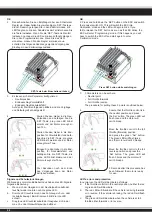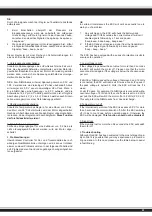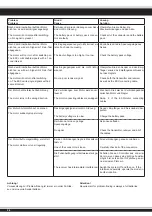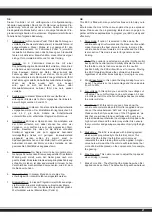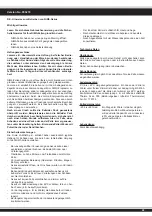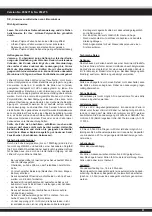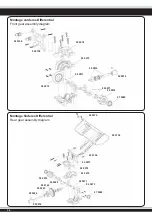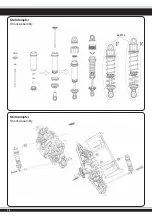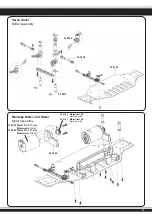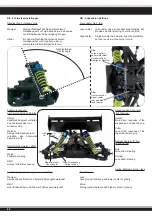
27
DE
] % Y-
< I O ' \ -
grammierung schnell und sicher erreichen, halten Sie sich an
die abgebildete Menüstruktur und an die obige Tabelle der Pro-
grammiermöglichkeiten. Die einzelnen Programmierschritte der
@j
1. = jOJ < =:
vorwärts, die Bremse ist dabei aktiviert, rückwärts fahren ist
ausgeschlossen. Dieser Modus ist gut geeignet für den
; :I O = < >
rückwärts mit Bremse) kann das Fahr-zeug auch rückwärts
fahren mit aktivierter Bremsfunktion, dieser Modus eignet
sich gut für normale Einsätze und für das Training.
# j O I =
\\J< I;
* "' J< "
Zone bewegen, bremst der Motor. Dabei kommt das
=: : I ; _:
J< "'<
das Fahrzeug rückwärts, dabei hält es zunächst kurzzeitig an.
Wenn der Geber wieder nach vorn bewegt
wird, egal ob sich der Motor im Brems- oder
J< ?
vorwärts.
2. ' jO $x "
wirkung der Bremse als %-Wert vorgegeben. Der Einstell-
bereich liegt zwischen 0 und 40%.
3. R \jO <<?
vorgegeben werden. Der Einstellbereich liegt zwischen 3,4
und 2,6 V pro Zelle. Sobald die Schaltschwelle
J$ I
4. "$ j $ \ <Y
der Start verlaufen soll, dabei können Sie unter vier
Vorgaben, vom sanften bis zum sehr aggressiven Start,
wählen. Beachten Sie, dass für die beiden schnellen
Startmodi ’aggressiv’ und ’sehr aggressiv’ besonders
?<< O
eingesetzt werden sollten. Es kommt sonst zu
Spannungseinbrüchen und der Motor läuft nur zögernd an.
Außerdem müssen der Motor und das Getriebe an den
gewünschten Start-Modus angepasst sein.
5. <
Ij J \\ :
Geberposition wirkenden Bremse ausgestattet. Die stärkste
Wirkung wird erzielt, wenn der Geber ganz nach vorn
gedrückt wird. Eine starke Bremswirkung bringt das Fahrzeug
schnell zum stehen, ist aber andererseits mit einem hohen
Verschleiß der mechanischen Komponenten, wie z.B. dem
Getriebe
verbunden.
6. Max. rückwärtsjO $<
j"
schwindigkeit für rückwärts fahren eingestellt werden.
7. Bremskraft min.jO <"
stellt werden wie stark die Bremse zu Beginn der Brems-
\ < IO
Wert wirksam wie bei Bremsstärke (Punkt 2).
GB
@ `] { \{
be
able to make the most of the various options they are explained
below. Please use the programming table shown on page 6 to-
gether with these explanations to program your ESC quickly and
{j
1. Drive
modejO\
vehicle will only drive forwards and the brake is active which
< IO
vehicle can be driven forwards or in reverse and the brake
is also active. This mode is useful for general use and
training.
Qj When option 2 is selected, moving the throttle control
<\ \{<IO
the throttle control is then moved back to the neutral
\ ^{`] I$
the ESC forwards will make the vehicle drive forwards
regardless of whether it was braking or moving in reverse.
2. Drag <jO \<
be set. The value is set as a percentage and the values are
from 0 to 40%
3. xjO \{
-off value. The cut-off voltage can be set between 3.4 and
I* \I"
the motor will stop.
4. $j With this option you can choose how the
vehicle will accelerate when full throttle is applied and you
can set the value between ‘Soft‘ and ‘Very Aggressive‘.
Please note that if you select one of the 2 ‘Aggressive’ mo
des that you will need to have batteries with a very low
internal resistance otherwise the voltage will drop due to the
high current draw and the motor may stutter. Also ensure
that your motor and gearing are capable of carrying the high
loads.
5. <$
Ij The ESC is equipped with a braking system
which works proportionally to the throttle control. This
means that the further the throttle control is moved
rearwards the more braking force will be applied. A higher
value here will mean that the vehicle will brake harder but
more strain will be placed on the components, for example,
the
gearing.
6. $
IJ j@ \ _ \ \
when driving in reverse
I <=$Ij@<
applied can be set here. The default setting will be whatever

